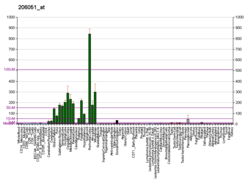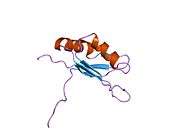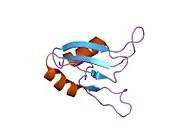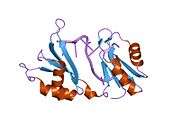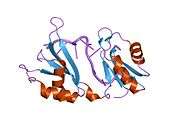HuD (protein)
HuD otherwise known as ELAV-like protein 4 is a protein that in humans is encoded by the ELAVL4 gene.[5][6]
The HuD/ELAVL4 protein is an RNA-binding protein.[7] HuD contains three RRM protein domains, enabling RNA binding.[8]
HuD is expressed only in neurons and it binds to AU-rich element-containing mRNAs. As a result of this interaction the half-life of the transcript is increased. HuD is important in neurons during brain development and plasticity.[9][10]
Interactions
References
- 1 2 3 GRCh38: Ensembl release 89: ENSG00000162374 - Ensembl, May 2017
- 1 2 3 GRCm38: Ensembl release 89: ENSMUSG00000028546 - Ensembl, May 2017
- ↑ "Human PubMed Reference:".
- ↑ "Mouse PubMed Reference:".
- ↑ Muresu R, Baldini A, Gress T, Posner JB, Furneaux HM, Siniscalco M (Dec 1993). "Mapping of the gene coding for a paraneoplastic encephalomyelitis antigen (HuD) to human chromosome site 1p34". Cytogenet Cell Genet. 65 (3): 177–8. doi:10.1159/000133626. PMID 8222755.
- ↑ "Entrez Gene: ELAVL4 ELAV (embryonic lethal, abnormal vision, Drosophila)-like 4 (Hu antigen D)".
- ↑ Szabo A, Dalmau J, Manley G, et al. (1991). "HuD, a paraneoplastic encephalomyelitis antigen, contains RNA-binding domains and is homologous to Elav and Sex-lethal". Cell. 67 (2): 325–33. doi:10.1016/0092-8674(91)90184-Z. PMID 1655278.
- ↑ "RNA-binding proteins in human genetic disease". Trends in Genetics. 24 (8): 416–425. 2008-08-01. doi:10.1016/j.tig.2008.05.004. ISSN 0168-9525.
- ↑ Nora Perrone-Bizzozero; Federico Bolognani (2002). "Role of HuD and other RNA-binding proteins in neural development and plasticity". J Neurosci Res. 68 (2): 121–126. doi:10.1002/jnr.10175. PMID 11948657.
- ↑ Federico Bolognani; Nora Perrone-Bizzozero (2008). "RNA-protein interactions and control of mRNA stability in neurons". J Neurosci Res. 86 (3): 481–489. doi:10.1002/jnr.21473. PMID 17853436.
- ↑ Saito, Kuniaki; Fujiwara Toshinobu; Katahira Jun; Inoue Kunio; Sakamoto Hiroshi (Aug 2004). "TAP/NXF1, the primary mRNA export receptor, specifically interacts with a neuronal RNA-binding protein HuD". Biochem. Biophys. Res. Commun. United States. 321 (2): 291–7. doi:10.1016/j.bbrc.2004.06.140. ISSN 0006-291X. PMID 15358174.
Further reading
- Dalmau J, Furneaux HM, Cordon-Cardo C, Posner JB (1992). "The expression of the Hu (paraneoplastic encephalomyelitis/sensory neuronopathy) antigen in human normal and tumor tissues". Am. J. Pathol. 141 (4): 881–6. PMC 1886624. PMID 1415481.
- Szabo A, Dalmau J, Manley G, et al. (1991). "HuD, a paraneoplastic encephalomyelitis antigen, contains RNA-binding domains and is homologous to Elav and Sex-lethal". Cell. 67 (2): 325–33. doi:10.1016/0092-8674(91)90184-Z. PMID 1655278.
- Graus F, Ferrer I (1990). "Analysis of a neuronal antigen (Hu) expression in the developing rat brain detected by autoantibodies from patients with paraneoplastic encephalomyelitis". Neurosci. Lett. 112 (1): 14–8. doi:10.1016/0304-3940(90)90314-Y. PMID 2166930.
- Sekido Y, Bader SA, Carbone DP, et al. (1994). "Molecular analysis of the HuD gene encoding a paraneoplastic encephalomyelitis antigen in human lung cancer cell lines". Cancer Res. 54 (18): 4988–92. PMID 8069866.
- Torà M, Graus F, de Bolòs C, Real FX (1997). "Cell surface expression of paraneoplastic encephalomyelitis/sensory neuronopathy-associated Hu antigens in small-cell lung cancers and neuroblastomas". Neurology. 48 (3): 735–41. doi:10.1212/wnl.48.3.735. PMID 9065557.
- Lazarova DL, Spengler BA, Biedler JL, Ross RA (1999). "HuD, a neuronal-specific RNA-binding protein, is a putative regulator of N-myc pre-mRNA processing/stability in malignant human neuroblasts". Oncogene. 18 (17): 2703–10. doi:10.1038/sj.onc.1202621. PMID 10348344.
- Park S, Myszka DG, Yu M, et al. (2000). "HuD RNA recognition motifs play distinct roles in the formation of a stable complex with AU-rich RNA". Mol. Cell. Biol. 20 (13): 4765–72. doi:10.1128/MCB.20.13.4765-4772.2000. PMC 85909. PMID 10848602.
- Wang X, Tanaka Hall TM (2001). "Structural basis for recognition of AU-rich element RNA by the HuD protein". Nat. Struct. Biol. 8 (2): 141–5. doi:10.1038/84131. PMID 11175903.
- Beckel-Mitchener AC, Miera A, Keller R, Perrone-Bizzozero NI (2002). "Poly(A) tail length-dependent stabilization of GAP-43 mRNA by the RNA-binding protein HuD". J. Biol. Chem. 277 (31): 27996–8002. doi:10.1074/jbc.M201982200. PMID 12034726.
- Behrends U, Jandl T, Golbeck A, et al. (2002). "Novel products of the HUD, HUC, NNP-1 and alpha-internexin genes identified by autologous antibody screening of a pediatric neuroblastoma library". Int. J. Cancer. 100 (6): 669–77. doi:10.1002/ijc.10550. PMID 12209604.
- Aronov S, Aranda G, Behar L, Ginzburg I (2003). "Visualization of translated tau protein in the axons of neuronal P19 cells and characterization of tau RNP granules". J. Cell Sci. 115 (Pt 19): 3817–27. doi:10.1242/jcs.00058. PMID 12235292.
- Angenstein F, Evans AM, Settlage RE, et al. (2002). "A receptor for activated C kinase is part of messenger ribonucleoprotein complexes associated with polyA-mRNAs in neurons". J. Neurosci. 22 (20): 8827–37. PMID 12388589.
- Deschenes-Furry J, Belanger G, Perrone-Bizzozero N, Jasmin BJ (2003). "Post-transcriptional regulation of acetylcholinesterase mRNAs in nerve growth factor-treated PC12 cells by the RNA-binding protein HuD". J. Biol. Chem. 278 (8): 5710–7. doi:10.1074/jbc.M209383200. PMID 12468554.
- Strausberg RL, Feingold EA, Grouse LH, et al. (2003). "Generation and initial analysis of more than 15,000 full-length human and mouse cDNA sequences". Proc. Natl. Acad. Sci. U.S.A. 99 (26): 16899–903. Bibcode:2002PNAS...9916899M. doi:10.1073/pnas.242603899. PMC 139241. PMID 12477932.
- Plonquet A, Garcia-Pons F, Fernandez E, et al. (2004). "Peptides derived from the onconeural HuD protein can elicit cytotoxic responses in HHD mouse and human". J. Neuroimmunol. 142 (1–2): 93–100. doi:10.1016/S0165-5728(03)00269-8. PMID 14512168.
- Saito K, Fujiwara T, Katahira J, et al. (2004). "TAP/NXF1, the primary mRNA export receptor, specifically interacts with a neuronal RNA-binding protein HuD". Biochem. Biophys. Res. Commun. 321 (2): 291–7. doi:10.1016/j.bbrc.2004.06.140. PMID 15358174.
- Rousseau A, Benyahia B, Dalmau J, et al. (2005). "T cell response to Hu-D peptides in patients with anti-Hu syndrome". J. Neurooncol. 71 (3): 231–6. doi:10.1007/s11060-004-1723-1. PMC 2586925. PMID 15735910.
- Noureddine MA, Qin XJ, Oliveira SA, et al. (2005). "Association between the neuron-specific RNA-binding protein ELAVL4 and Parkinson disease". Hum. Genet. 117 (1): 27–33. doi:10.1007/s00439-005-1259-2. PMID 15827745.
- Rual JF, Venkatesan K, Hao T, et al. (2005). "Towards a proteome-scale map of the human protein-protein interaction network". Nature. 437 (7062): 1173–8. Bibcode:2005Natur.437.1173R. doi:10.1038/nature04209. PMID 16189514.
This article is issued from
Wikipedia.
The text is licensed under Creative Commons - Attribution - Sharealike.
Additional terms may apply for the media files.




